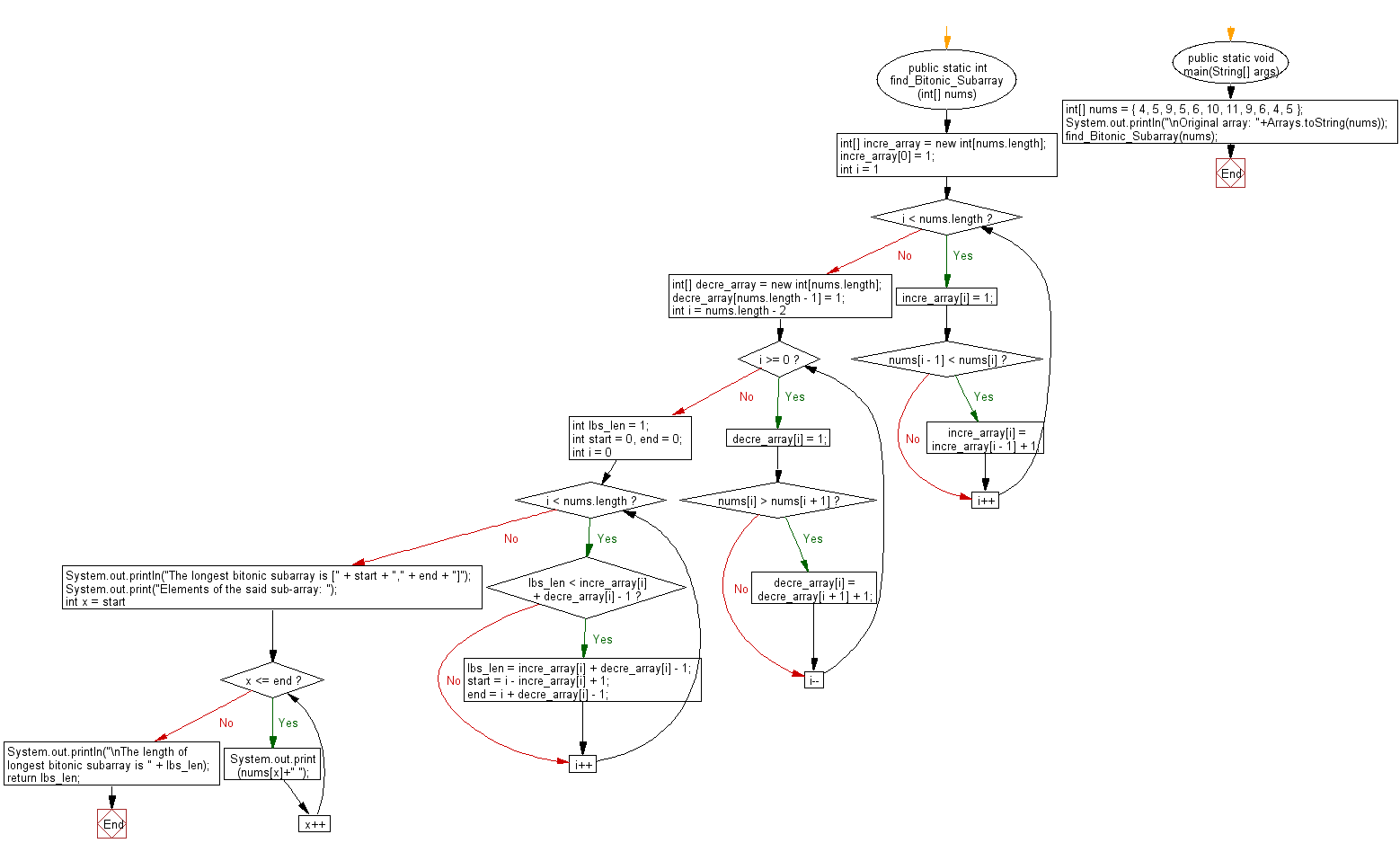Java: Find Longest Bitonic Subarray in a given array
64. Find longest bitonic subarray in an array
Write a Java program to find the Longest Bitonic Subarray in a given array.
A bitonic subarray is a subarray of a given array where elements are first sorted in increasing order, then in decreasing order. A strictly increasing or strictly decreasing subarray is also accepted as bitonic subarray.
Example:
Input :
nums = { 4, 5, 9, 5, 6, 10, 11, 9, 6, 4, 5 }
Output:
The longest bitonic subarray is [3,9]
Elements of the said sub-array: 5 6 10 11 9 6 4
The length of longest bitonic subarray is 7
Sample Solution:
Java Code:
// Import the necessary Java class.
import java.util.Arrays;
// Define a class named 'solution'.
class solution {
// Method to find the length and elements of the longest bitonic subarray.
public static int find_Bitonic_Subarray(int[] nums) {
// Initialize arrays to store increasing and decreasing lengths.
int[] incre_array = new int[nums.length];
int[] decre_array = new int[nums.length];
// Initialize the first element of the increasing array.
incre_array[0] = 1;
for (int i = 1; i < nums.length; i++) {
incre_array[i] = 1;
// Calculate increasing lengths based on the previous element.
if (nums[i - 1] < nums[i]) {
incre_array[i] = incre_array[i - 1] + 1;
}
}
// Initialize the last element of the decreasing array.
decre_array[nums.length - 1] = 1;
for (int i = nums.length - 2; i >= 0; i--) {
decre_array[i] = 1;
// Calculate decreasing lengths based on the next element.
if (nums[i] > nums[i + 1]) {
decre_array[i] = decre_array[i + 1] + 1;
}
}
int lbs_len = 1;
int start = 0, end = 0;
for (int i = 0; i < nums.length; i++) {
// Calculate the longest bitonic subarray.
if (lbs_len < incre_array[i] + decre_array[i] - 1) {
lbs_len = incre_array[i] + decre_array[i] - 1;
start = i - incre_array[i] + 1;
end = i + decre_array[i] - 1;
}
}
// Print the longest bitonic subarray.
System.out.println("The longest bitonic subarray is [" + start + "," + end + "]");
System.out.print("Elements of the said sub-array: ");
for (int x = start; x <= end; x++) {
System.out.print(nums[x] + " ");
}
System.out.println("\nThe length of the longest bitonic subarray is " + lbs_len);
return lbs_len;
}
// Main method to demonstrate finding the longest bitonic subarray in an array.
public static void main(String[] args) {
// Initialize an array.
int[] nums = { 4, 5, 9, 5, 6, 10, 11, 9, 6, 4, 5 };
System.out.println("\nOriginal array: " + Arrays.toString(nums));
// Call the 'find_Bitonic_Subarray' method to find and print the longest bitonic subarray.
find_Bitonic_Subarray(nums);
}
}
Sample Output:
Original array: [4, 5, 9, 5, 6, 10, 11, 9, 6, 4, 5] The longest bitonic subarray is [3,9] Elements of the said sub-array: 5 6 10 11 9 6 4 The length of longest bitonic subarray is 7
Flowchart:
For more Practice: Solve these Related Problems:
- Write a Java program to find the longest strictly increasing subarray.
- Write a Java program to find the longest strictly decreasing subarray.
- Write a Java program to find the maximum sum of a bitonic subarray.
- Write a Java program to determine whether a given array is bitonic or not.
Go to:
PREV : Replace each element with product of other elements.
NEXT : Find maximum difference between two elements in an array.
Java Code Editor:
What is the difficulty level of this exercise?
Test your Programming skills with w3resource's quiz.

